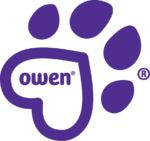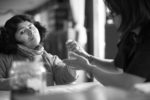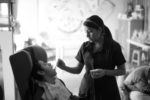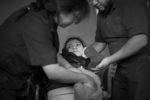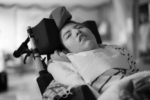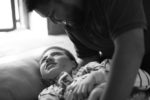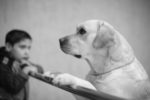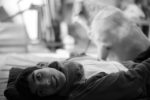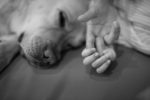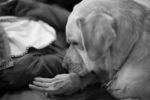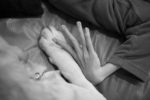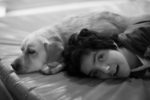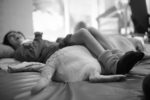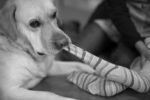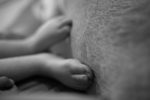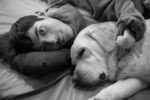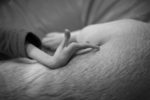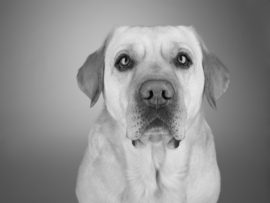
Owen
We had the tremendous honor in producing a video and various photos for The Owen Foundation in Mexico City., which has developed a program of “Rehabilitation without Pain” using assistance dogs in physical rehabilitation for children and young people with severe multiple disabilities (SMD).
First approaching this project, I remembered a quote from photographer Diane Arbus in the preface of the book Diane Arbus: An Aperture Monograph:
Most people go through life dreading they’ll have a traumatic experience. Freaks were born with their trauma. They’ve already passed their test in life. They’re aristocrats.
Reading Diane’s text, it became clear that presenting those children on the point of view of pity was not the correct way to help them. Witnessing the profound and delicate interaction in between the dogs and the children was an enlightening experience, going from pity to admiration. In a way, as much as those children needs our help, we need them so we can learn again to value the smallest moment, the fact we can walk, interact and speak.
Direction: Jean Bérard
Photography: Jean Bérard
Producer: Mary Palma
First assistant: Eduardo Solis
Second assistant: Ana Karen Garcia Fajardo
Edition: Armond Cohen
Writing: Hernan Bravo Varela / Teresa Zaga Cohen
Translation: Blair McDougall
Music: “Delicate” by Damien Rice, licensed courtesy of Warner Music UK LTD
Tuvimos el tremendo honor de producir un video y varias fotos para la Fundación Owen en la Ciudad de México, que desarrolló un programa de “rehabilitación sin dolor” utilizando perros de asistencia en rehabilitación física para niños y jóvenes con discapacidades múltiples severas (DSM).
Al acercarme a este proyecto, recordé una cita de la fotógrafa Diane Arbus en el prefacio del libro Diane Arbus: Una Monografía de Apertura:
“La mayoría de las personas pasan por la vida temiendo tener una experiencia traumática. Los “anormales” nacieron con su trauma. Ya pasaron la prueba en la vida. Son aristócratas (nobles)”.
Al leer el texto de Diane, quedó claro que presentar a esos niños en el punto de vista de la pena no era la forma correcta de ayudarlos. Ser testigo de la interacción profunda y delicada entre los perros y los niños fue una experiencia inspiradora, que pasó de la pena a la admiración. En cierto modo, por mucho que esos niños necesiten nuestra ayuda, los necesitamos para que podamos aprender nuevamente a valorar el momento más pequeño, el hecho de que podemos caminar, interactuar y hablar.
Dirección: Jean Bérard
Fotografía: Jean Bérard
Productor: Mary Palma
Primer asistente: Eduardo Solis
Segundo asistente: Ana Karen Garcia Fajardo
Edición: Armond Cohen
Escritor: Hernan Bravo Varela / Teresa Zaga Cohen
Traductor: Blair McDougall
Música: “Delicate” por Damien Rice, Licencia cortesía de Warner Music UK LTD

Also part of the project was photographing everyday situations at the Owen Foundation.
- Ana Marcela (22 years old) has a right hemimegalencephaly disability that reduces her left mobility but also impacts some cognitive functions that are located in the right hemisphere of her brain, such as attention and sensory perception. To help her, she is presented with an exercise of motor coordination and attention where she has to move an object.
- Due tu a moderate spastic cerebral palsy (CP), Obed (16 years old) brain didn’t arrived to the necessary maturity in order to develop mobility in his legs and arms and some cognitive functions were also affected (reduced vision, low attention). Children with congenital disabilities have a life expectancy ranging from 5 years to 30 years and depends on of the quality of care received.
- n some cases, cerebral palsy disabilities (CP) have a genetic origin but in the case of Andrea (19 years old) the disability originated from a meningitis that caused part of the left side of her brain to stops working when she was 5 years old. Initially, the prognosis was very poor and her life expectancy was 15 years old. She is now 19 years. A special chair must be adapted to each specific part of her body and help slow her physical decline in order to preserve a better position to breathe and eat.
- Owen is a 4 years old assistance dog that helps young people and children with severe disabilities to do their physical rehabilitation. Labrador Retrievers are especially suitable as assistance dogs for their friendly nature and even temperament. These dogs become facilitators for the children and helps them make their physical rehabilitation exercise on their own so they can achieve new goals.
- Victor, (15 years old) has West syndrome, which is an uncommon form of epilepsy accompanied by a slowdown in the development of the child, or even a regression. Spasms can disappear under treatment, but sometimes leave important intellectual and motor effects. Victor is totally dependent on other people for his vital functions: food, personal care, auto care.
- In many cases of multiple disabilities, children are suffering from various medical complications as can be digestive and respiratory difficulties, epilepsy. Many organs can be affected at different levels. In the case of Victor, the simple fact of having phlegm in the respiratory system can choke him. For this reason, the proximity of an assistant at all times is paramount and causes a continuous stress to all family members.
- Axel, six years old, has moderate cerebral palsy (CP) but in his case can reach better mobility even if his movements are not well controlled. Without constant treatments and physical therapies, he might loose over time muscle elasticity and the little amount of mobility he has. Children with severe multiple disabilities (SMD) have a dynamic that constantly impairs their quality of life and that of their families. The family faces continued losses: illusions, economic, neglect of a parent, social rejection, etc.
- Cesar is 19 years old and has severe cerebral palsy (CP). His legs and arms have muscle rigidity and his digestive and breathing system are very delicate. In his case, the cognitive functions are very good and he intent to communicate. Difficulties to do so can be desesperating for him.
- After suffering a respiratory attack where he choked on his saliva, Victor receives from Jorge comfort through an emotional and physical bond. Beyond physical rehabilitation, these children need emotional support to feel accompanied and secure.
- Damaris, 19 years old, has spastic and dystonic cerebral palsy (CP), where some of her muscles became completely rigid and others have no muscle tone allowing movement. Damaris posture is heavily modified by her condition. She needs specifically modified chairs and equipments to suit her morphology.
- Owen, the assistance dog, first contact with Cesar at the start of a therapy session. During traditional therapy where the therapist tries to move the child according to the therapeutic needs, the risk of fracture is very high due to muscles contractions and pains the child suffers. Hence the need to develop new techniques where the child perform these movements on his own. The emotional and sensory bond with the dog act as a motivator.
- Interaction in between Cesar and Owen hands. Throughout the various therapies, it is posible to note the development of an emotional bond in which the child begins to make hand movements previously impossible to perform. Those movements helps him to slow the progression of the physical degeneration.
- Angelica is 14 years old and suffers severe cerebral palsy (CP). Her disability is mostly physical and her cognitive functions are more present. Despite her reduced vision, Angelica is able to interact with her immediate environment.
- Angelica during a therapy with Owen where she is working on the extension of her legs through sensory interaction. Because of their everyday environment, children with multiple disabilities often do not have the experience of interacting using their senses. Developing this type of sensory experience is very important to motivate them in participating and enriching their environment.
- In many cases children with multiple disabilities were hurt by inadequate therapies, so they have much apprehension to undress. With assistance dog, a trust relationship is established, which allow children to be more relaxed.
- Due to the multiple seizures that Victor suffers, he has developed a strong feet sensibility. One of his therapeutic needs is to work on the position of his back and feet but it is very important to control the amount of stimulus in order to prevent another seizure.
- Because of Cesar’s disabilities, his left arm is completely contracted along his bust, unable to move it. The therapists specifically position him in this position with the assistance dog in order to work on this difficult movement.
- Without the correct motricity, Cesar instinctively grab Owen with the back of his hand. In Mexico alone, over 5% of the population has some form of disability, of these, 9% suffers from multiple disabilities that may be congenital or acquired.
In the year 2010, people with disabilities amounted to 5,739,270, 5.1% of the total population of our country [Mexico]. People with severe multiple disabilities represent 9% of the disabled population, more than 500,000 are completely physically and emotionally dependent.
Some of these children and young people receive attention from institutions of private assistance with traditional rehabilitation methods that are invasive and painful for them, their parents and profesionals helping them. (www.owen.care)This project has been made inside a foundation that has developed a program of “Rehabilitation without Pain” using assistance dogs. The medical program in physical rehabilitation for children and young people with severe multiple disabilities (SMD) launched by the Owen Foundation is the context of these photographs.
The images presented here, do not seek to make the promotion of the Foundation, at least, not completely, but to unveil and to experience physical, human and animal emotional relations occurring there.
These sometimes tremendously intense relationships are the result of the coexistence in between handicapped children, their assistance dogs and the people who supports and care for them every day.
After interacting with each of the individuals, it is impossible to not feel touched by the way in which these children make contact with their immediate world and those who are close to them. Small and almost imperceptible signs of gratitude, joy, at times frustration and pain, pushes us to reasses the most basic apreciation of our lives.
No less important is the role that Owen, an assistance dog, has represented for the rehabilitation of the children. He has given them the oportunity to experience another type of feelings and desires to move and interact. It has become another member of the family that helps them every day to adapt to this difficult world that they had arrived into.
The photographs that make up the project, still in process, intends to make something not often visible or that we do not want to see, by exploring on delicateness, nobility and generosity as an awakening to life.
Jorge Edgar Hernández, Curator.
Thank you so much to Rodolfo Morin for the new identity design and Armond Cohen for the video edition.
Special thanks to Margara Bravo, founder of the Owen Foundation and … Owen for changing the life of so many children and their families.
Please make a difference and donate at owen.care.
